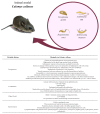Calomys callosus: An Experimental Animal Model Applied to Parasitic Diseases Investigations of Public Health Concern
- PMID: 35335694
- PMCID: PMC8948650
- DOI: 10.3390/pathogens11030369
Calomys callosus: An Experimental Animal Model Applied to Parasitic Diseases Investigations of Public Health Concern
Abstract
The appearance and spread of parasitic diseases around the world aroused the interest of the scientific community to discover new animal models for improving the quality and specificity of surveys. Calomys callosus is a rodent native to South America, an easy handling model, with satisfactory longevity and reproducibility. C. callosus is susceptible to toxoplasmosis and can be used as experimental model for the study the pathogenesis, treatment, vertical transmission, and ocular toxoplasmosis. C. callosus can also be used to study cutaneous and visceral leishmaniasis, as the animals present cutaneous lesions, as well as parasites in the organs. C. callosus has epidemiological importance in Chagas disease, and since it is a Trypanosoma cruzi natural host in which rodents show high parasitemia and lethality, they are also effective as a model of congenital transmission. In the study of schistosomiasis, Schistosoma mansoni was proven to be a C. callosus natural host; thus, this rodent is a great model for fibrosis, hepatic granulomatous reaction, and celloma associated with lymphomyeloid tissue (CALT) during S. mansoni infection. In this review, we summarize the leading studies of parasitic diseases that used C. callosus as a rodent experimental model, describing the main uses and characteristics that led them to be considered an effective model.
Keywords: Calomys callosus; Leishmania; Schistosoma mansoni; Toxoplasma gondii; Trypanosoma; animal model; parasitic diseases; public health.
Conflict of interest statement
The authors declare no conflict of interest.
Figures

References
-
- Moojen J. Os Roedores do Brasil. Instituto Nacional do Livro; Rio de Janeiro, Brazil: 1952.
-
- Hershkovitz P. Evolution of Neotropical Cricetine Rodents (Muridae) with Special Reference to the Phyllotine Group. Chicago Natural History Museum; Chicago, IL, USA: 1962.
-
- Massoia E., Fornes A. Nuevos dados sobre la morfologia distribucion geografica y etoecologia de Calomys callosus (Rengger) (Rodentia Cricetidae) Physis. 1965;25:325.
-
- Mello D.A., Moojen L.E. Nota sobre uma coleção de roedores e marsupiais superiores de algumas regiões do cerrado do Brasil central. Rev. Bras. Pesqui Med. Biol. 1979;12:287–291. - PubMed
-
- Petter F., de Karimi Almeida C.R. A new laboratory rodent, Cricetida Calomys callosus. Comptes Rendus Hebd. Séances L’académie Sci. 1967;265:1974–1976. - PubMed
Publication types
LinkOut - more resources
Full Text Sources

